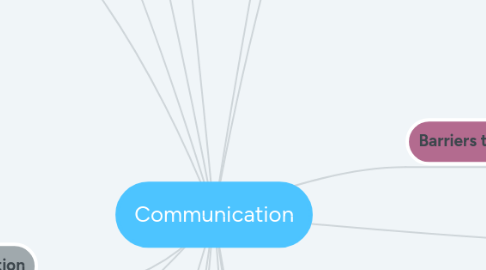
1. Definion
1.1. Its a two way process of exchanging of Opinions, News, Infromation by writing, speech or gestures including body language and Facial reactions. Ex: Mailing a letter to a friend , sending an email to a co-worker , Calling a friend on a telephone
2. Elements
2.1. MESSAGE
2.2. SOURCE ( sender)
2.3. CHANNEL
2.4. RECIEVER
2.5. FILTER
2.6. FEEDBACK
3. Types of Communication
3.1. The Channel should be
3.2. VERBAL
3.3. NON-VERBAL
3.4. WRITTEN
3.5. E-BASED
3.6. APPROPRIATE
3.7. AFFORDABLE
3.8. APPEALING
4. Categories of Non-Verbal Communication
4.1. KINESICS
4.1.1. Posture
4.1.2. Gesture
4.1.3. Facial Experation
4.1.4. Eye Contact ( Oculesics )
4.2. PARALANGUAGE
4.2.1. Pitch
4.2.2. Rate
4.2.3. Volume
4.2.4. Inflection ( Process of word formation)
4.3. HAPTICS
4.3.1. Touch ( Appropriate and Inapropriate)
4.4. PROXEMICS
4.4.1. Space ( Personal and Public )
4.5. ENVIRONMENT
4.5.1. Room shape
4.5.2. Arrangement
4.5.3. Access
4.5.4. Lighting
4.5.5. Noise
4.5.6. Color
4.5.7. Seating arrangement
4.6. PRESENTATION
4.6.1. Physical Appearance
4.6.2. Clothing choice
4.7. ARTIFACTS
4.7.1. Personal Objects that reflect and annouce identity ; how we personalize our space
5. Therapeutic Communication
5.1. Is a combination of verbal and non-verbal communication techniques that improve patientt's Physical and mental wellbeing.
5.2. Sometimes called Effective Communication, it is purposeful and goal-oriented, creating the beneficial outcome for the client.
5.3. Therapeutic Communication is one of the most valuable tool that nurses have to use to build rapport and trust. It has been Highlighted that nursing is an significant healing interpersonal process by using good communication skills the nurse can develop and maintain a helping nurse patient relationship
6. Goals of therapeutic Communication
6.1. To obtain or provide information
6.2. To Develop trust
6.3. To show caring
6.4. To explore feelings
7. Enhancing Communication
7.1. Self-Disclosure
7.2. Caring
7.3. Geniunness
7.4. Warmth
7.5. Active listening
7.6. Empathy ( The Capacity to understand other one's feelings )
7.7. Acceptance and Respect
8. Influences On Communication
8.1. Age
8.2. Education
8.3. Emotions
8.4. Culture
8.5. Language
8.6. Attention
8.7. Surroundings
9. Factors influence effective communication
9.1. Development & Gender
9.2. Socioculture Characteristics
9.3. Values and Perception
9.4. Personal Space
9.5. Roles and Relationships
9.6. Environment
9.7. Stage of illness
9.8. Level of Conciousness
9.9. Attitudes
10. The Communication Process
10.1. Sender ( encodes)
10.1.1. Medium
10.1.1.1. Reciever ( decodes )
10.1.1.1.1. Feedback/Response
11. What are the most common ways we communicate?
11.1. SPOKEN WORD
11.2. WRITTEN WORD
11.3. VISUAL IMAGES
11.4. BODY LANGAUGE
12. Characteristics of effective communication
12.1. Effective communication requires the message to be;
12.1.1. Clear and concise
12.1.2. Accurate
12.1.3. Releavant to the needs of reciever
12.1.4. Timely
12.1.5. Meaningful
12.1.6. Applicatble to the situation
12.2. The Reciever should
12.2.1. Be aware
12.2.2. Intrested
12.2.3. And willing to accept the message
12.2.4. Listen attentively
12.2.5. Understand the value of message
12.2.6. Provide feedback
13. Effective Communication Techniques
13.1. Accepting
13.2. Asking Open Questions
13.3. Broad Opening
13.4. Clarifying
13.5. Focusing
13.6. Observations
13.7. Reflection
13.8. Summarizing
13.9. Active Listening
13.10. Collaborating
13.11. Exploring
13.12. Giving Recognition
13.13. Offering self
13.14. Restatement or paraphrasing
13.15. Validating Perceptions
14. Non-Therapeutic Techniques
14.1. 1)Overloading
14.1.1. Talking rapidly,Changing Subjects too often,and asking for more infromation than can be absorbed at one time
14.1.2. "Whats your name? I see like sports, Where do you live?
14.2. 2)Value Judgements
14.2.1. Giving one's own opinion,evaluating,moralizing or implying one's value by using words such as: " nice" , "bad","right","wrong".
14.3. 3)False Assurance/Agreement
14.3.1. "Its going to be right."
14.4. 4)Invalidation
14.4.1. Ignoring or dnying another's presence,thoughts or feelings.
14.4.2. Client: How are you?
14.4.3. Nurse responds: I can't talk now , i am too busy
14.5. 5) Focusing on self
14.5.1. Responding in a way that focuses attention to the nurse instead of the client.
14.5.2. "This sunshine is good for my roses,I have beautiful rose at Garden"
14.6. 6)Arguing
14.6.1. "How can you say you did'nt sleep a wink when I heard you snoring all night long!!"
14.7. 7) Changing the Subject
14.7.1. Introducing new topic inappropriately,a pattern that may indicate Anxiety.
14.7.2. "The Client is Crying, when the nurse asks "How many children do you have ?"
14.8. 8)Giving Advice
14.8.1. Telling the client what to do,Giving opinions or making decisions for the client,nurse is accepting responsibility.
14.8.2. "If I were you...Or it would be better if you do it this way "
14.9. 9) Defensive Responses
14.9.1. No none here intetionally lie to you,"when client express criticism".
15. Barriers to Communication
15.1. Steriotyping
15.2. Agreeing and Disagreeing
15.3. Being defensive
15.4. Challenging
15.5. Probing
15.6. Testing
15.7. Rejecting
15.8. Changing topics
15.9. False Reassuarance
15.10. Passing Judgement
15.11. Giving Common advice
16. Phases of Nurse-Client Communication and Relationship
16.1. Pre-Orientation phases
16.1.1. When the nurse plans for the First session with the patient by gathering information and reviewing records.
16.2. Oreintation phase
16.2.1. Fairly short; Expactations clarified; mutual goals set
16.3. Working phases
16.3.1. Major portion of the interaction used to accomplish the goals outlined in introduction; feedback from client essential.
16.4. Termination phases
16.4.1. Nurse asks if client has Question; summarizing the topic is another way to indicate closure.
